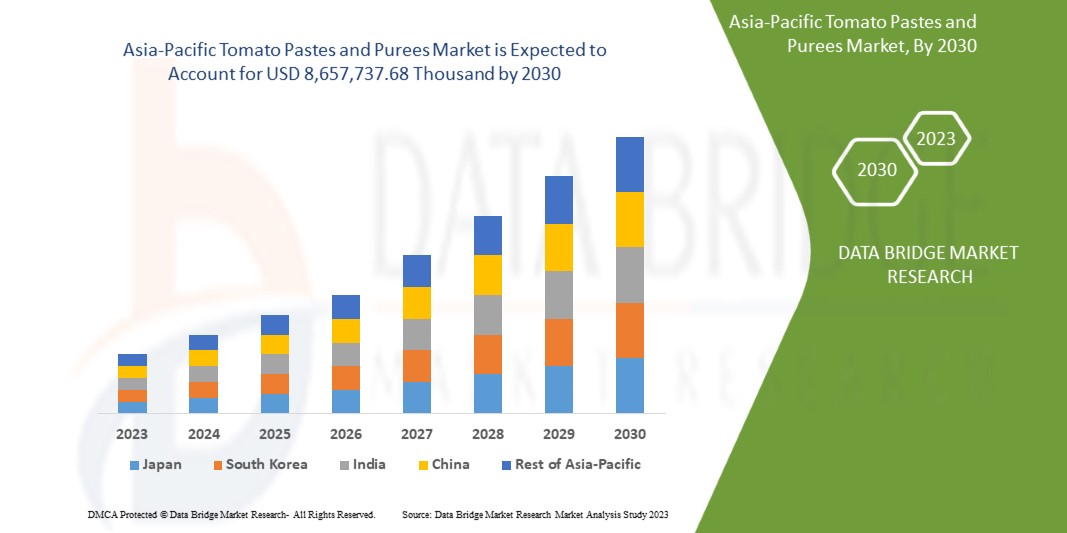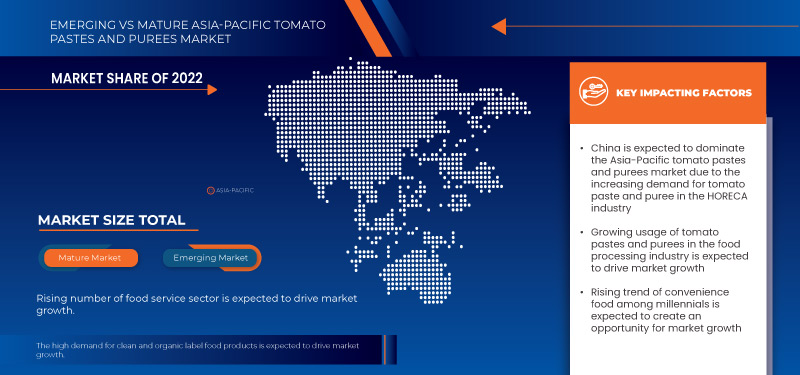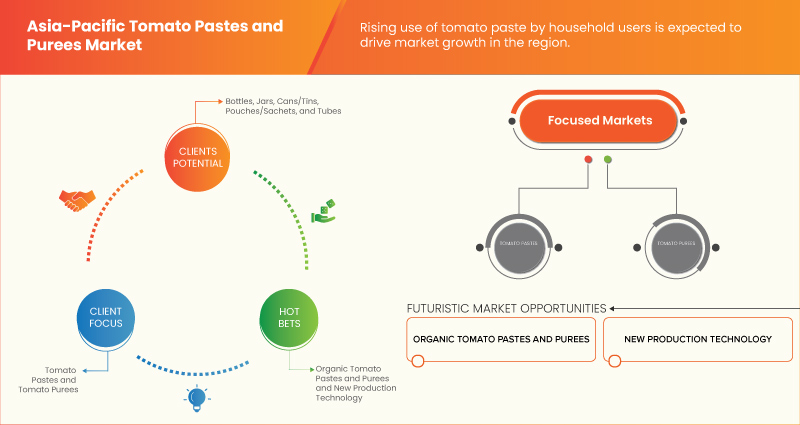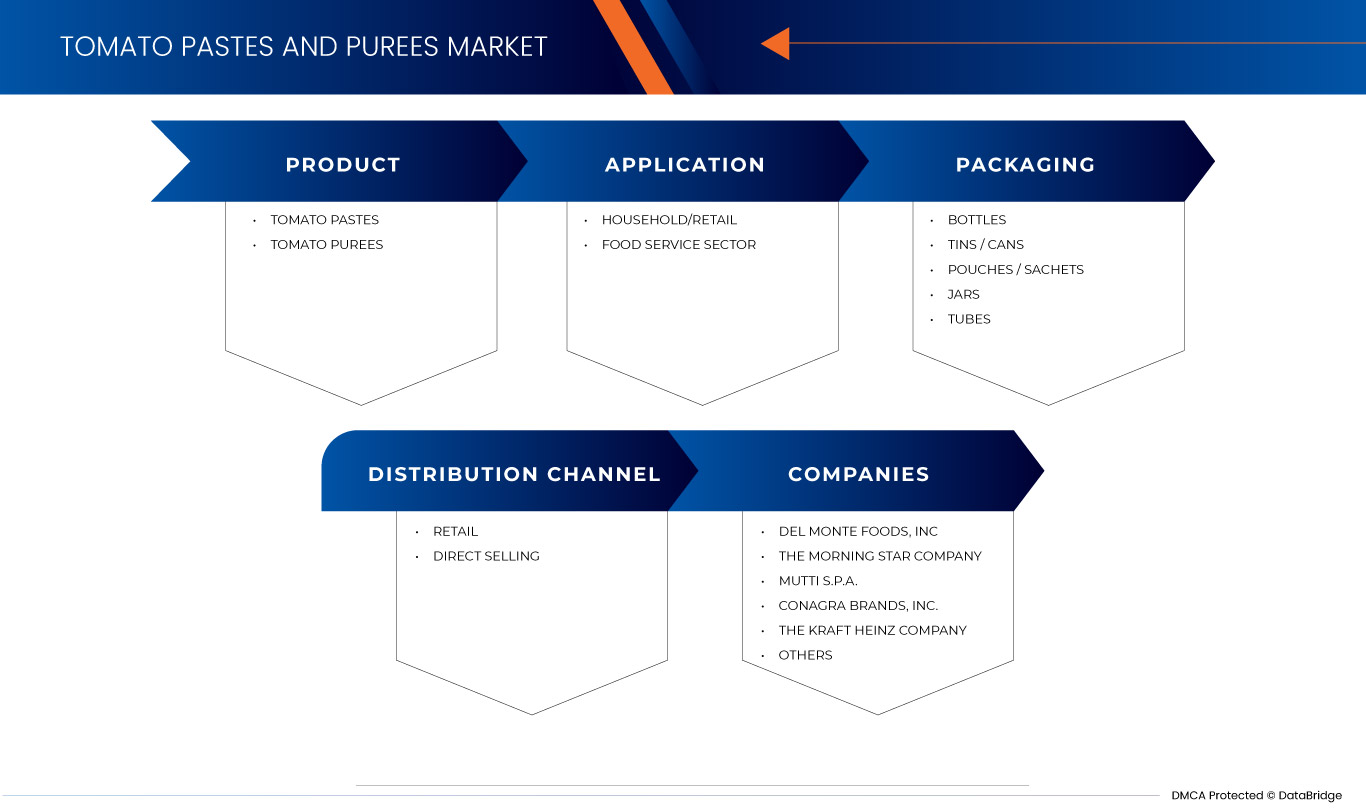Asia-Pacific Tomato Pastes and Purees Market, , By Product (Tomato Pastes and Tomato Purees), Packaging (Bottles, Tins/Cans, Pouches/Sachets, Jars, and Tubes), Application (Household/Retail and Food Service Sector), Distribution Channel (Direct Selling and Retail) - Industry Trends and Forecast to 2030.

Asia-Pacific Tomato Pastes and Purees Market Analysis and Insights
Tomato puree is the result of blending fresh tomatoes into a creamy paste with a liquid consistency. Growing usage of tomato pastes and purees and the rising demand for organic and clean-label food are expected to drive market growth. Furthermore, new and modern automated technologies may serve as an opportunity for market growth. However, high equipment and industrial costs and government regulations may pose a serious challenge to market growth.


The demand for tomato paste and puree is increasing, for which manufacturers are now more focused and involved in the new product launch, promotion, awards, certification, and event participation in the market. These decisions are ultimately enhancing the market growth.
Data Bridge Market Research analyzes that the Asia-Pacific tomato pastes and purees market is expected to grow with a CAGR of 4.5% in the forecast period of 2023 to 2030 and is expected to reach USD 8,657,737.68 thousand by 2030.
|
Report Metric |
Details |
|
Forecast Period |
2023 to 2030 |
|
Base Year |
2022 |
|
Historic Year |
2021 (Customizable to 2015 - 2020) |
|
Quantitative Units |
Revenue in USD Thousand |
|
Segments Covered |
Product (Tomato Pastes and Tomato Purees), Packaging (Bottles, Tins/Cans, Pouches/Sachets, Jars, and Tubes), Application (Household/Retail and Food Service Sector), Distribution Channel (Direct Selling and Retail) |
|
Countries Covered |
China, Japan, Australia, India, South Korea, Malaysia, Singapore, Indonesia, Thailand, Philippines, New Zealand, Taiwan, Vietnam, and rest of Asia-Pacific |
|
Market Players Covered |
Neil Jones Food Company, General Mills Inc., Pacific Coast Producers, Mutti S.p.A., Galla Foods, Dabur, The Kraft Heinz Company, Olam Group, Del Monte Foods, Inc, Ariza b.v., Chitale Agro, Conagra Brands, Inc., Riviana Foods Pty Ltd., and The Morning Star Company among others |
Market Definition
Tomato puree is a thick liquid made by cooking and straining tomatoes. Tomato paste is a thick paste made by cooking tomatoes for several hours to reduce the water content, straining out the seeds and skins, and cooking the liquid again to reduce the base to a thick, rich concentrate. It is used to impart an intense tomato flavor to a variety of dishes, such as pasta, soups, and braised meat.
Market Dynamics
This section deals with understanding the market drivers, advantages, opportunities, restraints, and challenges. All of this is discussed in detail as below:
Drivers
- Growing Usage of Tomato Pastes and Purees in the Food Processing Industry
Tomato pastes and purees are concentrated forms of tomatoes that are widely used in the food processing industry for their flavor, color, and nutritional value. They are made by cooking fresh tomatoes and reducing them into a thick and rich paste, which can be used in a variety of applications such as sauces, soups, stews, and other dishes. The use of tomato paste and puree in food processing industries has been growing steadily in recent years, as it offers several advantages over other forms of tomatoes. One of the main benefits of using tomato paste and puree is its long shelf life, which allows food manufacturers to store it for extended periods. Additionally, because tomato pastes and purees are concentrated, it is easier and more cost-effective to transport and store them than fresh tomatoes. The use of tomato paste and puree in the food processing industry is also driven by their affordability and availability. Tomatoes are a widely available crop, and the production of tomato paste and puree can be done at a large scale, making them a cost-effective ingredient for food manufacturers. They can use tomato paste and puree as base ingredients in the production of many tomato base dips and sauces.
For instance,
- In August 2022, according to ABC Fruits, approximately 80% of tomatoes are consumed fresh, while the remaining 20% are processed into tomato paste and puree. Tomato paste is a basic material used in the production of tomato-based goods. The sauce and ketchup industry consumes the most tomato paste
- In April 2021, according to QUADRO LIQUIDS BLOG, the tomato ketchup or sauces that are made by using tomato paste can provide high-quality ketchup with a thick consistency due to the fibrous strands in the paste that retain water and the natural pectin found in tomatoes that cause gelling
Thus, the production of pizza and pasta sauces, ready-to-eat meals such as frozen dinners and canned chili, snack foods, meat, and seafood products manufacturers use tomato pastes and purees heavily in the food processing industry, that have a major impact on the market and are expected to drive market growth in near future.
- Increasing Demand for Tomato Paste and Puree in HORECA Industry
Tomato puree and paste are highly versatile and convenient ingredients that can be used in a wide range of dishes. They can be easily stored and have a long shelf life, making it a convenient choice for busy kitchens. They are flexible ingredients that may be utilized in a variety of cuisines, making them a must-have in the HORECA industry. They can be included in spaghetti sauces, pizzas, stews, and soups among others. Chefs and cooks can save time and effort by using them. They can be used as a base for sauces and soups, reducing preparation and cooking time and allowing for faster and more efficient service. Furthermore, there has been an increase in the desire for healthy and natural ingredients in recent years, also tomato paste and puree provide a healthy option. They are made from ripe and juicy tomatoes that are high in nutrients such as vitamin C and lycopene, which makes them an appealing alternative. Moreover, tomato puree and paste are often more cost-effective than fresh tomatoes, especially when they are out of season or when large quantities are needed. This makes it an attractive option for restaurants and cafes looking to manage their food costs.
The expansion of the food service industry, which includes restaurants and fast food chains, has raised the potential demand for ketchup, sauce, puree, juice, and other tomato-based goods. The tomato sauce is eaten with snacks such as rolls, cutlets, chops, and soups and it is utilized in the culinary applications of other continental and Chinese foods as a complementary dish or a side dish. Because of the Westernization of food consumption patterns, there has been a growth in the use of tomato-processed goods in a variety of culinary applications.
Opportunity
-
Rising Trend of Convenience Food among Millennials
The growing popularity of convenience foods among millennials has been a noticeable trend in recent years. Convenience food is meals that are pre-packaged, pre-prepared, or ready-to-eat and are intended to be quick and easy to consume. Millennials frequently lead hectic lives, leaving little time for cooking and meal preparation. Convenience meals provide a quick solution and save time and effort in the kitchen. They can drink pre-prepared tomato paste and puree given by many producers due to the convenient availability of tomato paste and puree without the hassle of cleaning, sorting, and cooking. Moreover, the tomato paste and puree add a rich and concentrated tomato flavor to food products. They enhance the taste of sauces, soups, stews, and other convenience foods, providing a more vibrant and robust tomato profile. In addition, the tomato paste and puree are easy to incorporate into various recipes due to their concentrated form. They can be added to a wide range of convenience food products including pasta sauces, ready-to-eat meals, canned soups, pizza toppings, and more. Consumers, especially millennials are following the trend of consuming easily available and convenient food items, which are expected to create immense opportunities for market growth.
For instance,
-
In March 2023, according to a research article published in Research Gate, the demand for food products is gradually increasing among consumers. The millennial generation is shifted towards easily available and easy-to-cook food items
-
In December 2020, according to an article published in Petrosoftinc, 43% of consumers aged 18 to 29 (Millennials and Generation Z) had purchased more food from a convenience shop in the last three years.
-
In the U.S., c-stores saw record in-store sales in 2019, up 2.2% from the previous year, with younger Americans driving the trend for convenience store food
Hence, the rising trend of consuming easy-to-use and convenient food among millennials is expected to create opportunities for market growth.
Restraint/Challenge
- Fluctuation in the Prices of Raw Materials
The sudden fluctuation of prices in tomato has made manufacturing companies to plunge into a deep crisis, especially in the COVID-19 situation and recent economic crises and recessions. With the volatile prices of tomatoes, the production of many tomato-based products also suffers.
Tomato is cultivated under different climatic and environmental conditions. However, due to severe changes in weather conditions, there has been an upsurge in the prices of tomatoes. The fluctuation in the prices of tomatoes may restrain the market growth.
For instance,
- According to Selina Wamucii, the producer prices for tomatoes have fluctuated in the major production regions of the U.S. The cost of one kg of tomatoes packed and prepared for shipment in Washington and New York is approximately USD 3.28. In the years 2016, 2017, 2018, and 2019, the cost of exporting tomatoes per tonne in the U.S. was USD 1,047.30, USD 1,056.13, USD 1,027.28, and USD 1,030.08, respectively. In 2023, the wholesale price of tomatoes is estimated at the price range of around USD 1.03 per kg
- In September 2022, according to a FreshPlaza article, since the start of 2022, tomato prices in the U.S. have dropped 2% from USD1.93 per pound to USD1.89 per pound in August
- In January 2022, according to The Times of India, the seasonal components put pressure on the prices of tomatoes every year in India. The pattern of tomato production affects the supply chain of tomatoes resulting in high prices.
Thus, such fluctuation in tomato prices may result in a disturbed supply chain, as it results in increased cost of production and less profit margins.
Post-COVID-19 Impact on Asia-Pacific Tomato Pastes and Purees Market
COVID-19 has affected the market to some extent. Due to the lockdown, the trade of tomato pastes and purees across the world was severely affected due to quarantine measures, influencing the market. Due to the change in many mandates and regulations, manufacturers can design and launch new products in the market, which will help in the market growth.
Recent Developments
- In November 2022, Green Thumb Grown Foods, the largest producer of organic canned tomatoes in the Western U.S., launched the Take Root Organics line of products available at major retailers throughout the country, offering consumers an affordable option to choose organic food products that are good for their health and for the environment. The Take Root Organics line includes six different varieties, including tomato paste, which can be found in retail stores such as Kroger, Albertsons, and Food4Less.
- In February 2019, Goodpack Pte Ltd. introduced the TomatoCube a novel solution that enhances efficiency and volume for transporting products cost-effectively and sustainably.
Asia-Pacific Tomato Pastes and Purees Market Scope
The Asia-Pacific tomato pastes and purees market is segmented into four notable segments based on product, packaging, application, and distribution channel. The growth amongst these segments will help you analyze major growth segments in the industries and provide the users with a valuable market overview and market insights to make strategic decisions to identify core market applications.
Product
- Tomato Pastes
- Tomato Purees
On the basis of product, the market is segmented into tomato pastes and tomato purees.
Packaging
- Bottles
- Tins/Cans
- Pouches/Sachets
- Jars
- Tubes
On the basis of packaging, the market is segmented into bottles, jars, tins/cans, pouches/sachets, and tubes.
Application
- Household/Retail
- Food Service Sector
On the basis of application, the market is segmented into household/retail and food service sector.
Distribution Channel
- Direct Selling
- Retail
On the basis of distribution channel, the market is segmented into direct selling and retail.

Asia-Pacific Tomato Pastes and Purees Market Regional Analysis/Insights
The Asia-Pacific tomato pastes and purees market is analyzed and market size insights and trends are provided based on product, packaging, application, and distribution channel as referenced above.
The countries covered in this market report are China, Japan, Australia, India, South Korea, Malaysia, Singapore, Indonesia, Thailand, Philippines, New Zealand, Taiwan, Vietnam, and rest of Asia-Pacific. China is expected to dominate the Asia-Pacific tomato pastes and purees market in terms of market share and market revenue due to the growing demand for tomato paste and puree in the HORECA industry.
The country section of the report also provides individual market-impacting factors and changes in market regulation that impact the current and future trends of the market. Data point downstream and upstream value chain analysis, technical trends, Porter's five forces analysis, and case studies are some of the pointers used to forecast the market scenario for individual countries. Also, the presence and availability of regional brands and their challenges faced due to large or scarce competition from local and domestic brands, the impact of domestic tariffs, and trade routes are considered while providing forecast analysis of the country data.
Competitive Landscape and Asia-Pacific Tomato Pastes and Purees Market Share Analysis
The Asia-Pacific tomato pastes and purees market competitive landscape provides details by competitors. Details included are company overview, company financials, revenue generated, market potential, investment in research and development, new market initiatives, production sites and facilities, company strengths and weaknesses, product launch, product trials pipelines, product approvals, patents, product width and breadth, application dominance, technology lifeline curve. The above data points provided are only related to the companies’ focus related to the market.
Some of the major market players operating in this market are Neil Jones Food Company, General Mills Inc., Pacific Coast Producers, Mutti S.p.A., Galla Foods, Dabur, The Kraft Heinz Company, Olam Group, Del Monte Foods, Inc, Ariza b.v., Chitale Agro, Conagra Brands, Inc., Riviana Foods Pty Ltd., and The Morning Star Company among others.
SKU-
Get online access to the report on the World's First Market Intelligence Cloud
- Interactive Data Analysis Dashboard
- Company Analysis Dashboard for high growth potential opportunities
- Research Analyst Access for customization & queries
- Competitor Analysis with Interactive dashboard
- Latest News, Updates & Trend analysis
- Harness the Power of Benchmark Analysis for Comprehensive Competitor Tracking
Asia Pacific Tomato Pastes And Pures Market, Supply Chain Analysis and Ecosystem Framework
To support market growth and help clients navigate the impact of geopolitical shifts, DBMR has integrated in-depth supply chain analysis into its Asia Pacific Tomato Pastes And Pures Market research reports. This addition empowers clients to respond effectively to global changes affecting their industries. The supply chain analysis section includes detailed insights such as Asia Pacific Tomato Pastes And Pures Market consumption and production by country, price trend analysis, the impact of tariffs and geopolitical developments, and import and export trends by country and HSN code. It also highlights major suppliers with data on production capacity and company profiles, as well as key importers and exporters. In addition to research, DBMR offers specialized supply chain consulting services backed by over a decade of experience, providing solutions like supplier discovery, supplier risk assessment, price trend analysis, impact evaluation of inflation and trade route changes, and comprehensive market trend analysis.
Research Methodology
Data collection and base year analysis are done using data collection modules with large sample sizes. The stage includes obtaining market information or related data through various sources and strategies. It includes examining and planning all the data acquired from the past in advance. It likewise envelops the examination of information inconsistencies seen across different information sources. The market data is analysed and estimated using market statistical and coherent models. Also, market share analysis and key trend analysis are the major success factors in the market report. To know more, please request an analyst call or drop down your inquiry.
The key research methodology used by DBMR research team is data triangulation which involves data mining, analysis of the impact of data variables on the market and primary (industry expert) validation. Data models include Vendor Positioning Grid, Market Time Line Analysis, Market Overview and Guide, Company Positioning Grid, Patent Analysis, Pricing Analysis, Company Market Share Analysis, Standards of Measurement, Global versus Regional and Vendor Share Analysis. To know more about the research methodology, drop in an inquiry to speak to our industry experts.
Customization Available
Data Bridge Market Research is a leader in advanced formative research. We take pride in servicing our existing and new customers with data and analysis that match and suits their goal. The report can be customized to include price trend analysis of target brands understanding the market for additional countries (ask for the list of countries), clinical trial results data, literature review, refurbished market and product base analysis. Market analysis of target competitors can be analyzed from technology-based analysis to market portfolio strategies. We can add as many competitors that you require data about in the format and data style you are looking for. Our team of analysts can also provide you data in crude raw excel files pivot tables (Fact book) or can assist you in creating presentations from the data sets available in the report.













